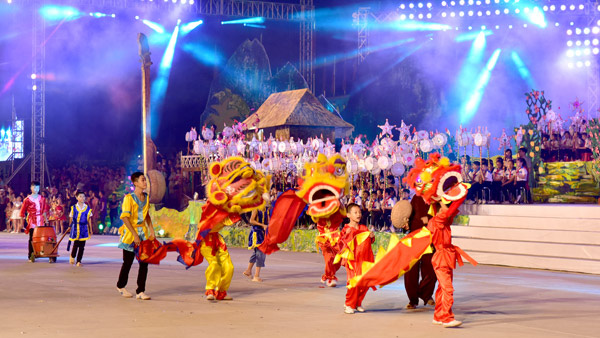Mid-Autumn Festival
The Mid-Autumn Festival, one of the most traditional and popular family holidays in Viet Nam, is enjoyed by people throughout the country, regardless of their background or economic status.
 |
| Lion dancing |
The mid-autumn festival, which is believed to originate in China and celebrated by many Asian countries, including Viet Nam, falls on the 15th day of the 8th month on the lunar calendar.
This year's the festival falls on 4 October.
The Mid-Autumn or ‘Trung Thu’ Festival is associated with the legend of Cuoi, a popular Vietnamese fairy tale that explains the origin of the festival.
According to the legend, a man named Cuoi was very famous because he owned a magic banyan tree that could cure any illness. Cuoi’s wife got angry because Cuoi seemed to love the tree more than her. So one day when Cuoi was out treating a sick neighbour, she poured dirty water on the roots of the tree, which made it leave the ground. Cuoi suddenly returned at that very moment to see the tree fly up to the sky. He tried to grab it but failed to pin it down and was taken up to the moon, where he lives together with his tree to this day. That’s why every year children light lanterns and take part in processions on the day of the festival to show Cuoi the way back to Earth!
In Viet Nam, there are many traditional activities for both adults and children during the festival, including lion dances performed by both professional and amateur groups. Lion dance groups perform on the streets and go to houses asking for permission to perform for the people living there. If they are accepted by the hosts, the ‘lion’ will go in and start dancing to wish the household good luck and fortune.
The Earth Lord, ‘Ong Dia’, dances around the dragon, urging it on. 'Ong Dia', who has a smiling moon-shaped face, represents the prosperity and wealth of the earth.
On the occasion of the festival, parents buy their children rattles, drums and star lanterns. Many children also take great interest in traditional paper toys, lion heads and masks of animals from old tales, as well as modern battery-run plastic ships or tanks with remote controls.
The tradition of the Mid-Autumn festival is reflected in the way the children play games. They carry beautifully ornate lanterns while singing and parading along the streets in a candlelight procession at dawn. The candles represent brightness and the procession symbolises success in school. The lanterns come in different sizes and shapes such as fish and butterflies. There are also spinning lanterns in which candles can be inserted to represent the sun surrounded by the earth.
Mid-Autumn Festival parties in the evening are a good opportunity for children to enjoy the festive food, and also learn things from their parents such as how to make the party attractive. The whole family will enjoy the feast in a cozy and sacred atmosphere.
Quite a few foreign visitors to Viet Nam are also interested in the mid-autumn festival, and some even bring mooncakes back to their home countries as special gifts for their friends.
 |
| Mooncakes |
Mooncakes are an indispensable delicacy for this festival. For generations, mooncakes have been made with sweet fillings of nuts, mashed red beans, lotus seed paste or sweet bean paste, depending on the region. Sometimes a cooked egg yolk can be found in the middle of the rich tasting dessert. People compare mooncakes to the plum pudding and fruit cakes served during the English Christmas holidays.
Vietnamese mooncakes are typically square rather than round, although round ones do exist. They are offered amongst friends or at family gatherings during this festival. The cakes are usually cut into small wedges and eaten accompanied by green tea because they are so sweet.
(Source: http://english.vov.vn/ DA NANG Today)




